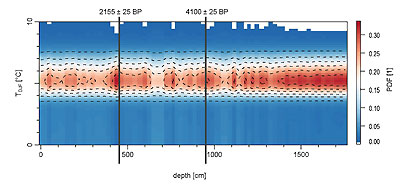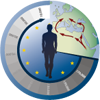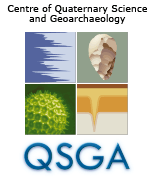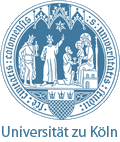Quantitative climate information is an essential tool when attempting to answer questions regarding early Holocene environment and possible human impact.
Whereas continuous climatic measurements are only available for the last 100 years, for the past – and especially for the prehistoric periods – we are dependent on other sources, referred to as proxy data. In project B3 we assume that the presence of plants (determined by pollen) in a certain area is a marker for prevailing climate conditions. These data are best harnessed using probabilistic transfer functions. The nature of these transfer functions is – and must be - probabilistic due to the fact that the climate biosphere is a complex high dimensional stochastical system.
The result of the reconstruction can be described by a conditional probability density function (PDF) for the climate state of the past ![]() , given the fossil pollen spectra
, given the fossil pollen spectra ![]() (the pollen counts), the recent climate data X and the recent proxy data Y:
(the pollen counts), the recent climate data X and the recent proxy data Y:
![]()
For the analysis of the pollen samples from the Sea of Galilee and Birkat Ram in Israel, we use two different methods, both developed at the Meteorological Institute at the University of Bonn.
The climate reconstruction for each pollen sample of the drilling core of the Sea of Galilee has recently been completed.
 Climate reconstruction of winter temperature for each pollen sample layer. Photo: Benno Thoma |


















